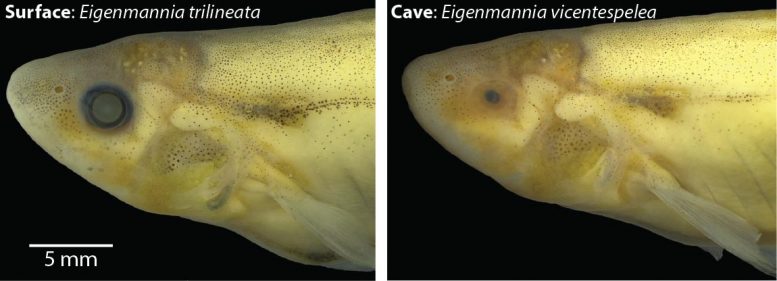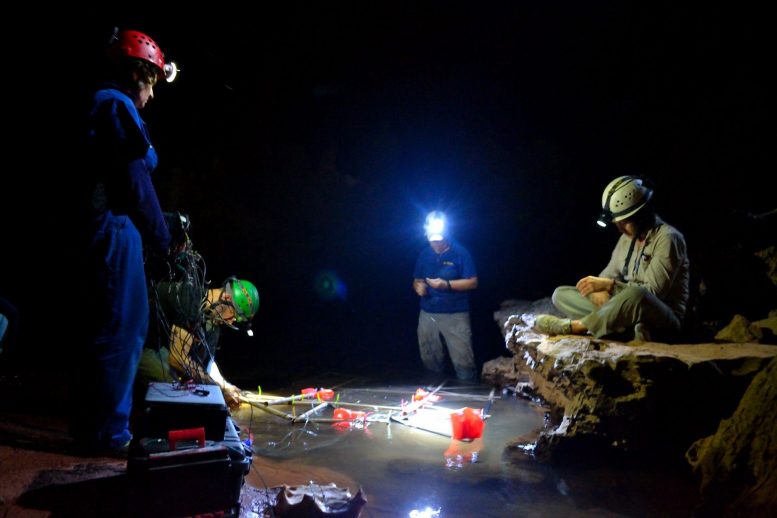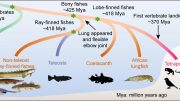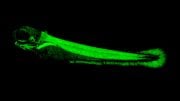From Brazil’s Amazon, researchers report “spooky interactions” among surface- and cave-dwelling electric fish, revealing shocking behavior of 300 blind cavefishes whose ancestors adopted life in darkness tens of thousands of years ago.
A study of weakly electric fishes from a remote area of the Brazilian Amazon Basin has not only offered a unique window into how an incredibly rare fish has adapted to life in caves over tens of thousands of years, it has also revealed for the first time that electric fish are able to interact with each other over longer distances than known possible in a way similar to AM radio.
In findings published in the journal Frontiers, researchers have shown how a cave-adapted glass knifefish species of roughly 300 living members (Eigenmannia vicentespelea) has evolved from surface-dwelling relatives (Eigenmannia trilineata) that still live just outside their cave door — by sacrificing their eyes and pigmentation, but gaining slightly more powerful electric organs that enhance the way they sense prey and communicate in absolute darkness.
The study, which analyzed the fishes’ electric-based communication and behavior, has detailed the discovery that weakly electric fishes tap into a special channel for long-distance messaging via changes in the amplitude of electrical signals sent to one another. Researchers have adapted Einstein’s famous quote on the theory of quantum entanglement — “spooky interaction at a distance” — to describe how the weakly electric fishes perceive these social messages, altering each other’s behavior at distances up to several meters apart.
Of the nearly 80 species of cavefish known today to have evolved from surface-dwelling fish, all have developed sensory enhancements of some kind for enduring cave life, commonly adapting over millions of years while losing sensory organs they no longer need in the process.
However, biologists have questioned how weakly electric fishes, which use their electrical senses for navigating the dark and murky conditions of the Amazon River, might also adapt — either evolving heightened electric senses to see and communicate in absolute darkness, or by powering down their electric fields to save on energetic cost when most caves have few food resources.
“One of the big questions about fish that successfully adapt to living in caves is how they adapt to life without light,” said Eric Fortune, lead author of the study and biologist at New Jersey Institute of Technology (NJIT). “My colleagues were split between two groups … one group that predicted that the electric fields of the cavefish would be weaker due to limited food supplies, and another that bet that the electric fields would be stronger, allowing the fish to use their electric signals to see and talk more clearly in the complete darkness of the cave.

Contrast between two distantly related species of transparent knifefish neighboring each other in Central Brazil’s Upper Tocantins river basin, in the state of Goiás. The surface-dwelling fish Eigenmannia trilineata (left) inhabits the Rio da Lapa at the mouth of the São Vicente II Cave where the blind cavefish Eigenmannia vicentespelea (right) has adapted to life without light over tens of thousands of years. Credit: NJIT
“It seems that using their electric sense to detect prey and communicate with each other is quite valuable to these animals; they have greater electric field strengths. Interestingly, our analysis of their electric fields and movement shows that they can communicate at distances of meters, which is quite a long way for fish that are around 10cm in length.”
“Nearly all research of cavefish species until now has been limited to behavioral experiments in labs, and that is why this study is special,” said Daphne Soares, NJIT associate professor of biology and co-author on the study. “This is the first time we’ve been able to continuously monitor the behavior of any cavefish in their natural setting over days. We’ve gained great insight into their nervous system and specialized adaptations for cave life, but it’s just as exciting to learn how sociable and chatty they are with each other … it’s like middle school.”
Spooky Interactions & Shocking Adaptations
For the investigation, NJIT and Johns Hopkins researchers teamed with biologist Maria Elina Bichuette from the Federal University of São Carlos, who began studying the two groups of fish nearly two decades ago in the remote São Vicente II Cave system of Central Brazil’s Upper Tocantins river basin.
Over several days, the team applied a customized electric fish-tracking technique involving placing electrode grids throughout the fishes’ water habitats to record and measure the electric fields generated by each fish, allowing the team to analyze the fishes’ movements and electricity-based social interactions.
The researchers were able to track more than 1,000 electrical-based social interactions over 20-minute-long recordings taken from both surface and cavefish populations, discovering hundreds of specialized long-distance exchanges.
“When I began studying these fishes, we could watch behavior associated with these fishes’ unique and specialized morphology, but in this project, it was fascinating to apply these new technical approaches to reveal just how complex and refined their communication could be,” said Bichuette.
“Basically, our evidence shows that the fishes are talking to each other at distance through electricity using a secret hidden channel, amplitude modulations that emerge through the summation of their electric signals. It is not unlike how an AM radio works, which relies on amplitude modulations of a radio signal,” said Fortune.
The recordings also showed that strengths of electric discharges in the cavefish were about 1.5 times greater than those of surface fish despite coming at a cost of up to a quarter of their overall energy budget. The team conducted CT scans of both species, showing that the cavefish also possess relatively larger electric organs than their stream-mates, which could explain the source of the cavefishes’ extra electrical power. Another consequence of trading their eyes and surface life for heightened electrosensory perception is that the cavefish were more social and territorial at all hours. Unlike their freely foraging surface relatives that sleep during the day and forage at night, the cavefish lack a day-night cycle.
For now, the discovery of the fishes’ AM radio-style distant interactions is noted by Fortune as the first of its kind reported among electric cavefish, though he says similar phenomena is now being reported in some other species as well, recently by researchers in Germany who have observed a form of long-distance electrical communication among a group of fish known as Apteronotus. Fortune says the finding could have implications for the field of neurobiology, where weakly electric fish is a unique and powerful model for exploring the nature of the brain-body connection in other animals including humans.
“Electric fish are great systems for understanding the neural basis of behavior, so we have been studying their brains for decades,” said Fortune. “These new data are forcing a reexamination of the neural circuits used for the control of behavior of these fishes.”
Reference: “Spooky Interaction at a Distance in Cave and Surface Dwelling Electric Fishes” by Eric S. Fortune, Nicole Andanar, Manu Madhav, Ravikrishnan P. Jayakumar, Noah J. Cowan, Maria Elina Bichuette and Daphne Soares, 22 October 2020, Frontiers in Integrative Neuroscience.
DOI: 10.3389/fnint.2020.561524











Be the first to comment on "Shocking Adaptations and “Spooky Interactions” Discovered in Electric Fish of Brazil’s Amazon"